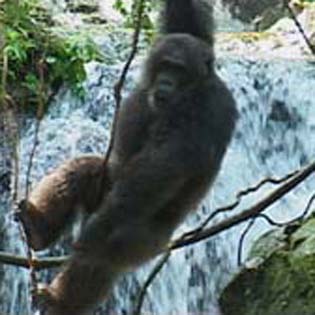 Bill Wallauer is a videographer, a colleague of Jane Goodall. Click here to read Bill’s observations of chimpanzees behaving in ways that are fascinating to consider. Bill observes males displaying at waterfalls and in thunderstorms as individuals and groups transition into the sexual-display mode of communication. Jane Goodall wrote a famous passage describing these events.
Bill Wallauer is a videographer, a colleague of Jane Goodall. Click here to read Bill’s observations of chimpanzees behaving in ways that are fascinating to consider. Bill observes males displaying at waterfalls and in thunderstorms as individuals and groups transition into the sexual-display mode of communication. Jane Goodall wrote a famous passage describing these events.
“All at once Evered charged forward, leapt up to seize one of the hanging vines, and swung out over the stream in the spray-drenched wind. A moment later Freud joined him. The two leapt from one liana to the next, swinging into space, until it seemed the slender stems must snap or be torn from their lofty moorings. Frodo charged along the edge of the stream, hurling rock after rock now ahead, now to the side, his coat glistening with spray. For ten minutes the three performed their wild displays while Fifi and her younger offspring watched from one of the tall fig trees by the stream. Were the chimpanzees expressing feelings of awe such as those which, in early man, surely gave rise to primitive religions, worship of the elements?” (Jane Goodall Through a Window (Boston: Houghlin Mifflin, 1990) pp. 241-242.)
I found Bill’s page within the janegoodall.org site while searching Google for evidence that chimpanzee or bonobo babies or children respond to music with movement or proto dance. Although I’ve hypothesized in several places on this blog that dance emerged after the chimpanzee/human lineage split, probably during homo erectus as brains grew at lightning speed, yesterday’s entry has me thinking that if music/dance is a postbirth manifestation of womb ontogenetic epigenetic processes, then perhaps there is evidence of a response to music in chimpanzee and bonobo youth. With bonobo exhibiting more neoteny than chimpanzees, bonobo babies and children would more likely exhibit an attraction to what we could interpret as proto music.
Evidently experiments have been conducted on human embryos in the womb to determine if brain waves suggested an integration of surrounding music and sound. It seemed that was the case. Click here. Do bonobo exhibit the same predilection? What other animals might reveal these trends? What might be common among different animals that do show a tendency to be sensitive to rhythm?
I am fascinated by the relationship the autistic have with music and rhythm. There is evidence that when language is tied to melody, it is easier for many with autism to absorb the words. The autistic have been observed to retain perfect pitch in higher percentages than the nonautistic. Several of those with autism that I have known personally felt a close affinity to music and dance. One autistic boy I worked with almost never spoke, yet occasionally he would break out into dance. In a subtle and interesting way, performance may be tied to the autistic experience. There are rhythmic features to chimpanzee displays, particularly with the aggressive repetition of loud noise. Perhaps the obsessive repetition associated with physical and aural exclamations in autism can be viewed as a combination of, or transition between, display and performance. Autistic communication often feels to me to be a performance of information featuring a repetition of remembered or rehearsed songs, jokes and snatches of conversation.
I am reminded of Baron-Cohen’s exploration of Savage-Rumbaugh’s chimpanzee explorations regarding theory of mind. If a chimpanzee demonstration can remind us so closely of a human performance, then perhaps certain autistic behaviors can be seen as a bridge between the two.
If obsessive repetition, rhythm or music are often integral to the autistic experience, and on occasion seem to behave as bridges that provide access to words and what words represent, then would an early and deep immersion in rhythm perhaps provide the autistic with an environment through which they could establish firm connections?
Clearly, if this experiment were conducted on the very young, it would more likely have a positive effect than when they are older. I don’t estimate there would be negative repercussions. If we surmise that autistic attraction to repetition, rhythm and performance suggests a need for an environment that reflects those features, perhaps a rhythm-and-performance-infused environment of the type experienced by humans just before or during the transition to culture and split consciousness will encourage a making of connections.
There was a time, perhaps as recently as 100,000 years ago, when we did not trade in symbols. We were still steeped in primary consciousness (one time, one place, no negatives) but were likely dancing up a storm. Waterfalls and thunderstorms no doubt moved us, but there is a good chance we often moved each other, performing movement to rhythm and sound.
The autistic may be a mere 4,000 generations from us, a couple neurological anomalies away. Perhaps all that is needed to bridge this distance is an ability for moderns to evolve a feeling for wordless, rhythmic performance, a feeling for living in the autistic now.
…
Proceed to author’s FREE book download on this subject (The book is called Evolution, Autism and Social Change). 10 minute introductory video here.
Andrew Lehman on 03/10/10 in featured, The Unconscious | 1 Comment | Read More
Comments (1)


Sounds reasonable to me. I don’t have perfect pitch, can’t even name or recognize the notes, but music has always made a deep impression on me. Kids should be exposed to classical music, the earlier the better. That’s not to say that the music has to be classical. I think that most autistic children would find “Gimme that ding!” mesmerizing, and their bodies would start to move to it. Using it to engage them could become part of a learning experience.